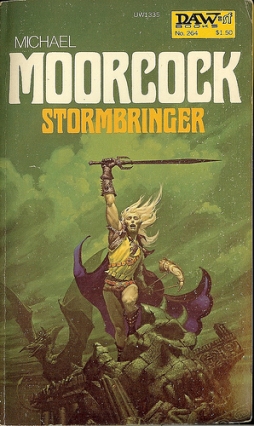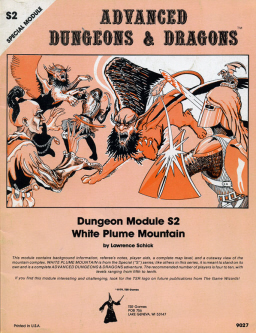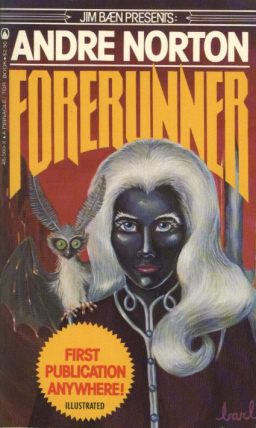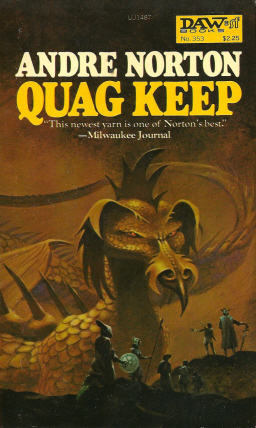Andre Norton, Michael Moorcock and Appendix N: Advanced Readings in D&D
 And so we come to two of the most influential and prolific fantasy writers of the 20th Century, Andre Norton and Michael Moorcock, as we follow intrepid literary explorers Mordicai and Tim Callahan on their voyage of discovery through Appendix N at Tor.com.
And so we come to two of the most influential and prolific fantasy writers of the 20th Century, Andre Norton and Michael Moorcock, as we follow intrepid literary explorers Mordicai and Tim Callahan on their voyage of discovery through Appendix N at Tor.com.
Tim and Mordicai have been none too gentle to some of the writers in Appendix N, including L. Sprague de Camp, Gardner Fox, and even Roger Zelazny. But in Norton and Moorcock, they find authors they can appreciate.
Here’s Tim on Michael Moorcock:
I read The Swords Trilogy and The Chronicles of Corum early, and they made an impact. They exploded inside my mind in a way I have never forgotten, even if I can’t remember many of the story details from any particular chapter… but I didn’t really feel like I tuned into Elric until halfway through the first reprint volume, when we get the four novellas of Stormbringer…
It’s classic Moorcock, in that imaginative and terrifyingly evocative way that I loved all those years ago when I first picked up The Swords Trilogy off a spinner rack in my hometown general store. Stormbringer begins with agents of chaos abducting Elric’s wife, and it takes off into the realm of mass warfare and conflicts with not-quite-dead-gods soon enough.
Moorcock aims for the mythic.
Read the complete article here.
Good to see a little love for classic sword & sorcery, but personally I don’t see a lot of direct influence from Elric on D&D — unless you count the section on powerful artifacts in the Dungeon Masters Guide, which clearly was conceived with weapons like Stormbringer in mind.
[Click on any of the images in this article for bigger versions.]
 Here’s Tim on the one documented instance where Stormbringer creeps into the game, early in TSR publishing history:
Here’s Tim on the one documented instance where Stormbringer creeps into the game, early in TSR publishing history:
And I’m glad you mentioned White Plume Mountain, because it’s a classic D&D adventure and though it doesn’t have a whole lot to do with the Elric mythos, specifically, the sword Blackrazor is clearly plucked from Moorcock’s works. Module writer Lawrence Schick even admitted that it was written as a kind of calling card to TSR to get hired as a game designer, and it worked, but he never would have included such an obvious Elric homage if he thought the module were going to see print as written. It’s pretty blatant.
Then again, the gang at TSR statted up Elric and his friends for the first printing of Deities and Demigods, so they didn’t hide their Moorcock affection from the public.
Elric is hardly Moorcock’s only creation however, so I don’t think it’s hard to draw a direct link from the author to Dungeons and Dragons.
Elric had a more direct influence in other aspects of fantasy gaming of course, as we recently examined in our Vintage Treasures article on Avalon Hill’s Elric Young Kingdoms Adventure Game.
We’ve also looked at much of Moorcock’s canon here on the blog, most recently The Warlord of the Air, his Von Bek novels, and his Hawkmoon books, including The Chronicles of Castle Brass.
We even published an original 30,000-word Eternal Champion story by Michael Moorcock in the first issue of Black Gate.
Tim and Mordicai find a much more concrete connection to Dungeons and Dragons in their next subject, however.
 Here’s Modricai on Andre Norton:
Here’s Modricai on Andre Norton:
Just looking at the cover art to Andre Norton’s Forerunner will start you thinking about Dungeons and Dragons, as the pitch black skin and pale white hair of the elfin figure immediately makes your thoughts go to the dark elves, the drow… The first thing I did, then, upon seeing the cover for this, was flip to the copyright page — 1981 — and then look up the drow on Wikipedia. The drow’s first official mention is in the AD&D Monster Manual, 1977, with their first appearance in Hall of the Fire Giant King (G3) in 1978, which really nailed down their signature “look.”
Just an odd coincidence? Perhaps not, since Norton definitely was affiliated with Gary Gygax and Dungeons and Dragons. She wrote Quag Keep in 1979, the first official D&D tie-in novel, about a group of people from the “real world.” How did she know so much about the hobby? Well, because she played in Gary Gygax’s Greyhawk game in 1976, of course.
I didn’t know Andre Norton played in Greyhawk.
I didn’t know Quag Keep was an “official” tie-in novel, either — I always thought the “Dragons and Dungeons” featured in the book was clearly inspired by D&D, but Norton made no attempt to tread on TSR’s intellectual property in the novel — which was published by DAW without any kind of license from TSR, official or otherwise.
Interestingly, the Wikipedia page on “Dungeons & Dragons (Novels)” seems to back up Mordicai’s claim that it’s an “official” tie in:
The first novel based on the Dungeons & Dragons game was Quag Keep (1978) by Andre Norton. Based upon Norton’s first experience at playing the Dungeons & Dragons game, it told the story of seven gamers who were drawn into a fantasy setting. The sequel, Return to Quag Keep (2006), was published after Norton had died in 2005.
 But whatever, I think they’re both wrong. My copy of Quag Keep (which fortunately was not in the basement, where it would be lost forever) has this acknowledgement:
But whatever, I think they’re both wrong. My copy of Quag Keep (which fortunately was not in the basement, where it would be lost forever) has this acknowledgement:
The author wishes to express appreciation for the invaluable aid of E. Gary Gygax of TSR, expert player and creator of the war game, Dungeons and Dragons, on which the background of Quag Keep is based. I wish also to acknowledge the kind assistance of Donald Wollheim, an authority and collector of military miniatures, whose special interest was so valuable for my research.
Never knew that bit about Don Wollheim and miniatures, or I would have mentioned it in my recent article. That’s cool stuff.
But back to Quag Keep. The first chapter is titled “Greyhawk,” and features D&D beasts such as lizardmen, but I still don’t consider it an “official D&D tie-in novel.”
Maybe this is splitting hairs (okay, it’s almost certainly splitting hairs), but the book imagines a D&D-like game that compels a party to come together in the City of Greyhawk, with bracelets and dangling dice that guide their destiny. It’s almost a metaphor for role playing, more than a typical Greyhawk novel.
Okay, now that I got that out of my system, I admit I was pleased to see just how much Mordicai enjoyed Andre Norton. She was a grand old lady of early SF who introduced countless young readers to science fiction and fantasy all through the 50s, 60s, 70s, and 80s, and even the 90s and the early part of the 21st Century, when she collaborated with writers like Mercedes Lackey, Jean Rabe, and A. C. Crispin — right up until her death in 2005, at the age of 93.
At the end of the day, Mordicai has plenty of kind words for Norton:
Of the books we’re read, this is the one that most resembles the campaign I actually run… All in all I’m really impressed; this is my favorite new book I’ve encountered so far in the Advanced Dungeons & Dragons series, I think, because it exposed me to Andre Norton. She sure can write, and she does an excellent job…
The complete article is here.
We last covered Mordicai and Tim’s journey into Appendix N on August 20th, when they discussed L. Sprague de Camp, Fletcher Pratt, and Gardner Fox. The list of authors they’ve covered includes:
Leigh Brackett and J.R.R. Tolkien
Margaret St. Clair and Andrew Offutt
Lord Dunsany and Philip José Farmer
H.P. Lovecraft and A. Merritt
Manly Wade Wellman and Fletcher Pratt
Fredric Brown and Stanley G. Weinbaum
John Bellairs and Fred Saberhagen
Jack Williamson and Lin Carter
Andre Norton and Michael Moorcock
L. Sprague de Camp, Fletcher Pratt, and Gardner Fox
Roger Zelazny and August Derleth
Jack Vance
Fritz Leiber and Edgar Rice Burroughs
Sterling E. Lanier
Poul Anderson
Robert E. Howard
See the complete list here.
…so one of the reviewers read halfway through the entire first collected Elric reprint before starting to be engrossed in Elric, but gave up on The Chronicles of Amber after reading only Nine Princes in Amber, a slim novel that would only be the first fifth of a modern epic fantasy?
I call foul. Not that Amber isn’t without its flaws, but… come on. The reviewer didn’t get any sense of the conflicting loyalties, the secrets piled upon secrets, the intrigues, the character arcs, because the first novel is just an introduction to the setting… and he completely overlooked all the hugely epic scenes that Corwin’s involved in, though he praises them in Moorcock.
Howard,
I know what you mean. Still… if a fantasy epic doesn’t grab you with the first volume, is there any sense in continuing?
I remember getting a lot of grief for giving up on David Eddings BELGARIAD series because I found the first book boring. People told me I had to hang in there until books two or three, until it really got good.
No, I don’t. If a fantasy series doesn’t grab you with the first book, it’s time to find a different series. There is simply too much out there for readers to waste time with books they don’t enjoy.
I wonder how much of it (giving up on Amber) was psychological because 9 Princes was a single physical book (assuming they didn’t just read the first bit of the Great Book of Amber). Would’ve been interesting to give them, say, the old SFBC omnibus with the first three volumes in it and see if they would’ve kept going and if that would’ve changed the evaluation.
Fair enough, John. I could never get past the first 100 pages of Donaldson.
But I am confused by the double standard I seem to see between the way Moorcock was handled over the way Zelazny was handled. There are plenty of astonishing epic moments in the first Zelazny novel (the battle up Mount Kolvir, anyone, or the trippy shadow rides) that can hold their own against any of Moorcock’s awesome scenes, and they barely get a mention in the review.
Okay…this is me just doing a “quick off the top of my head” list of things reflecting Moorcock’s influence on D&D.
1) The 9-Lives Stealer Sword (Elric)
2) The Mask Wearing worshipers of the Lost City — Granbretan of Castle Brass.
3) Alignment as a tangible thing. Too often players of D&D think of alignment as a “guideline,” but in a world with living manifestations of alignments (the 9 demigods captured by Zagyg Ygrne for example) this has never been the case.
4) The concept of “Balance” as manifest in Mordenkainen and Zagyg.
5) Intelligent Swords
6) The Eye and Hand of Vecna are straight out of the Corum books.
7) The Instant Fortress of Daern is very reminiscent of the Vanishing Tower in both Corum and Elric.
8) The war of the Drow and other Elves is reminiscent of the war between the Vadhagh and Nadragh.
9) Dragon’s limited use of breath weapon in first edition reflects the limitations in Stormbringer.
I am sure I can come up with more. Just let me say that when it comes to games, I think D&D is more Moorcock than even the Chaosium games — read Kobold Quarterly #5 for an interesting quote by Moorcock on his Chaosium deal.
John said, “personally I don’t see a lot of direct influence from Elric on D&D” (!).
The alignment system in 1st edition D&D (AD&D to us old guys!) and its connection to the original “outer planes” (i.e. their structure and how this constituted what creatures were where) was, it seems to me, a HUGE Moorcock Elric influence.
Christian, I’m pretty sure that the Eye and Hand of Vecna are in homage to Jack Vance.
The name Vecna is certainly an homage to Vance, but the artifacts themselves I think are Moorcock. The Hand of Kwll and the Eye of Rhynn are major artifacts in the Corum stories. The main character Corum Jhaelen Irsei uses them in the first trilogy in a most tragic way.
More on the Moorcock connection to those items here https://www.wizards.com/DnD/Article.aspx?x=dnd/4alum/20090121
> Would’ve been interesting to give them, say, the old SFBC omnibus with the first three volumes in it and see if they would’ve kept going
Joe,
Fascinating suggestion! That’s exactly how I read the Amber books. I have no real sense of the break between volumes, since I read all five books in the two-volume hardcover set from SFBC. And you’re right, I wonder if it would have made a difference?
I don’t know, though. I remember being captivated by the Amber Chronicles almost from the first page. If the magic didn’t work for Tim, it just didn’t work. I don’t get Eddings either, no matter how many times people tell me to keep trying.
> Okay…this is me just doing a “quick off the top of my head” list of things reflecting Moorcock’s influence on D&D.
Christian,
Wow! You clearly know your Moorcock a LOT better than I do.
You’re absolutely right about the alignment thing (especially the additional Law vs Chaos axis) being strongly influenced by Moorcock. Forgot all about that one.
I never read Corum or Castle Brass, so I’ll have to trust you on the others… but I’ll take your word for it. 🙂
> Read Kobold Quarterly #5 for an interesting quote by Moorcock on his Chaosium deal.
Oh come on… like I can find Kobold Quarterly #5 in the Realm of Chaos that is my basement. Give me a clue.
> The alignment system in 1st edition D&D (AD&D to us old guys!) and its connection to the original “outer planes”
> (i.e. their structure and how this constituted what creatures were where) was, it seems to me, a HUGE Moorcock Elric influence.
James,
Right again. That’s been discussed in numerous places, so I don’t even have a decent excuse for forgetting that one.
I’ve only read the first volume of the recent reprint of the Elric stories (“While the Gods Laugh” is my favorite), containing the first batch that Moorcock wrote, and while they’re quite stylish and imaginative in general, one thing that annoys me sometimes is Moorcock’s tendency to rush through major events without giving them much weight or detail.. for example, the appearance of a dragon in “The Dreaming City” should be awe-inspiring, but it’s described just briefly in the most perfunctory of terms. Moorcock has talked about how quickly many of these stories were written, without much or any revision, and it shows. Still, at some point down the line I’d definitely like to read more Elric.
> If the magic didn’t work for Tim, it just didn’t work. I don’t get Eddings either, no matter how many times people tell me to keep trying.
John — Yes, there’s much truth there. Any given book just won’t be for some readers — there’s plenty of stuff I’ve bounced off hard for whatever reason.
Hey Christian,
Good point on the Eye of Rhynn etc. I can’t believe I never noticed that! Especially because I’ve actually read the first Corum trilogy more times than I’ve read any other Moorock books, despite the fact they are pretty much the same plot each time through. I just loved the lyrical weirdness of those books.
I apologize for my knee-jerk dismissal of your assertion about the Moorcock/Vecna connection. You clearly know what you’re talking about!
best,
Howard
> Moorcock has talked about how quickly many of these stories were written, without much or any revision, and it shows.
Golgonooza,
No argument. I almost wish Moorcock hadn’t made those (now-famous) statements about writing many of his early novels in a matter of days. I used to see the free-wheeling plotlines (and especially the frequently gonzo endings) as non-linear storytelling… now I see them simply as the product of tight deadlines. Sorta diminshes the appreciation of the art, you know what I mean?
No offense taken Howard. Like you, I’ve read the Corum books more than any other Moorcock and it is the way they channel the “weird” that really gets me as well. Moorcock’s writing is at its most poetic in those stories and I love them.
I only read the second Corum trilogy once, when I was in junior high. The bleak, bleak ending really brought me down. I’ve been wondering if I’d appreciate it more now that I’m older, but there are so many other books I haven’t read once, so I haven’t looked into it (including The Warhound and the World’s Pain).
When you re-read Corum, did you read all six, or just the first trilogy?
[…] to be read later. As it happens, there’s been a certain amount of talk about Andre Norton lately, here and elsewhere, and that prompted me to finally turn to the original Witch World novel, and see what […]
[…] We last covered Mordicai and Tim’s journey into Appendix N on September 9th, when they discussed Andre Norton and Michael Moorcock. […]